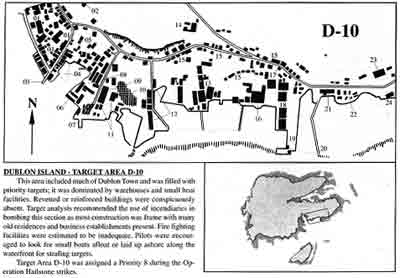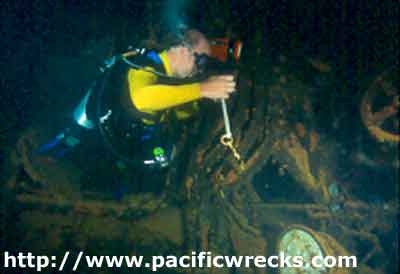Dan Bailey is the author of WWII
Wrecks of Palau and WWII
Wrecks of the Truk Lagoon an impressive, new,
and comprehensive edition that culminates over eight years
of new research, painstaking accuracy in creating maps, and
including over 150 color wreck photographs. For anyone interested
in Truk or Palau, these are definitive books.
Tell a little more about yourself, and your interest
in WWII
I was raised in an inland valley area in Northern
California (Redding). I went to college at Brigham Young University,
got an electrical engineering degree, and went to work for Lockheed
Missiles and Space Co. in the Silicon Valley. In 1969, I was offered
a job with GTE Sylvania working on the ALTAIR radar project on Roi-Namur
Island in the Kwajalein Atoll. Immediately after arriving, I got acquainted
with the fishermen on the island as I was a fishing fanatic. While being
around the dock area, I got acquainted with several divers who showed
me underwater photographs of the shipwrecks in the nearby lagoon along
with artifacts that they had recovered. These fascinated me as I had
always been interested in ship and WW II history since childhood days;
becoming a shipwreck diver was a natural progression.
After becoming a wreck diving fanatic at Kwajalein
and Roi-Namur, Truk was another natural progression with me as was Palau
(I wrote the book, WWII Wrecks of Palau, also.) The I-169 film definitely was interesting to me. I could not wait to
dive on a Japanese submarine! I have a copy of [ Jacques Cousteau's
1969 ] Lagoon of Lost Ships.
My first dives in 1971-72 were on a limited number
of wrecks that had been found. Few divers had ever visited these wrecks
and their structural integrity was almost completely intact; the sheer
number of artifacts, the coral growth, and the fish life around them
was phenomenal. Over the years, there was the opportunity on many trips
to dive on a newly found shipwreck. This was also a special highlight.
My dive groups and I were fortunate to find a couple aircraft and small
shipwrecks that had been unknown previously.
On my second or third trip to Truk, Kimiuo Aisek (who
introduced diving services at Truk) was having difficulties with a well-known
dive industry personage. This fellow, who was used to being catered
to, felt that he was not being taken care of. Kimiuo asked me to intervene
and help solve the misunderstanding. It took a simple explanation on
my part to the VIP and everything was solved. Kimiuo then kind of adopted
me following this and was my personal dive guide for many years. The
discussions about the wrecks and the many dives with Kimiuo were very
special. Having him show me the best that Truk had to offer was a major
highlight. When Kimiuo's health slowed him down, I was fortunate enough
to dive with his son, Gradvin, for many years also. I have a long personal
friendship relationship with several of the diving guides, including
Chenny Tipwek, and boat operators that is very gratifying.
At one point in my book-writing career, it became
important to me to keep track of the number of trips that I had made
to both Truk and Palau. In 1986, I went through my collection of slides
and jotted down the dates on them to help formulate a list of the
dates/years that I had been diving at these places. Old airplane tickets
and receipts helped in making the list. I may have lost track of one
trip date because I went without a working underwater camera and had
no slides to refer to. I did keep exact track of my trips (up to three
times per year) after 1986 and these now number more than 40 at both
Truk and Palau. I have been exploring Truk for the last 30 years with
only 2-3 years in the 1971-2001 time period that I missed going.
The most interesting artifact I have seen is
an optical signaling device. It is a rare find and its
presence on the ship belies the importance of the Heian Maru as
a sub-tender for the 6th Submarine Fleet.
The next most exciting artifact to me was a metal case
I found on the Nippo Maru filled with intricate and beautiful brass
navigational measurement instruments. This rusty-looking case was almost
covered completely with silt and it was a thrill pulling it out and
opening it up to find the beautiful instruments inside.
For those people who contact me about visiting and
diving at Truk for the first time, I tell them there is a major problem
in doing so. When they ask what that problem is, I tell them that after
going there they will not want to go anywhere else but Truk in the future.
Many get back to me after going and tell me I was right!
 Tell about your book on Truk Lagoon
Tell about your book on Truk Lagoon
World War II Wrecks of the Truk Lagoon is the culmination of eight years
of concentrated effort: diving exploration, travel, research, computer
drawing, and writing. It is my "flagship" works (so to speak)
and likely the last one I will produce. It will be updated in follow-on
editions/printings.
 The book's Target Area Maps were modified from those found in original intelligence
bulletins and the information included with them was derived from
a combination of photo-interpretation notes by analysts, post-war
sources, and my own analysis of various photos taken during the air
raids. I have an interest and background in photo-interpretation
analysis of enemy installations from working in intelligence related
projects during my Aerospace engineering career. There were hundreds
of hours spent in drawing / re-drawing these maps, compiling the
content information, and studying various action photos.
The book's Target Area Maps were modified from those found in original intelligence
bulletins and the information included with them was derived from
a combination of photo-interpretation notes by analysts, post-war
sources, and my own analysis of various photos taken during the air
raids. I have an interest and background in photo-interpretation
analysis of enemy installations from working in intelligence related
projects during my Aerospace engineering career. There were hundreds
of hours spent in drawing / re-drawing these maps, compiling the
content information, and studying various action photos.
There has been a lot of work involved in accumulating
wreck photos for this book. You have to be good with your photographic
techniques, have good equipment, and be lucky in some cases. The 150
color plates represent less than one percent of the total taken over
the years.
Many of the reports in the Air Campaign Section were
found after making intensive searches through the National Archives.
Much of this material has been mis-filed and in some cases was found
by luck only. Eight consecutive years of research in the Archives,
a week or more at a time, proved to be the answer to accumulating all
the information. New information was found every year. Correspondence
with Pacific War researchers has sled to tips where new material has
been found. These researchers have graciously shared information.
Ever so often, I am contacted by American WWII
pilots and other naval veterans about my book. In general, the pilots
who flew at Truk comment that it was hard understanding the big picture
based on their participation. They only learned about the total results
from reading my book.
 That is Peter Ording on the cover. Peter contacted
me in 1999 about joining me in a trip to Truk. He was able to do so
in July 2000. He is a great gentleman and an accomplished wreck diver.
Everyone on the trip enjoyed Peter; he was a great addition to the
group. I now consider him a valued friend. We will be going to Truk
together again (along with two of his best diving buddies) in February
2002.
That is Peter Ording on the cover. Peter contacted
me in 1999 about joining me in a trip to Truk. He was able to do so
in July 2000. He is a great gentleman and an accomplished wreck diver.
Everyone on the trip enjoyed Peter; he was a great addition to the
group. I now consider him a valued friend. We will be going to Truk
together again (along with two of his best diving buddies) in February
2002.
Talk about the changes to the shipwrecks
The deterioration of the wrecks is a sad thing to
see. I am very grateful to have been able to see the wrecks at their
best in my lifetime. Every time I visit Truk now-a-days or see dive
operators at stateside show, the guides and live-aboard folks make a
point of telling me of changes that have occurred (collapsing of superstructures,
deck guns falling to the seabed, etc.). It angers me when I hear about
the damaging of wrecks due to careless dive boat anchoring or other
man-produced means (like the dynamiting of the wheelhouse of the destroyer
Fumitsuki to get at a safe inside).
The looting of munitions and artifacts from the
wrecks is very disturbing to me. I love to try to get new and better
photos of some of the same artifacts trip after trip and delight in
showing them to new members of my diving groups. If these artifacts
are found to be missing, it is a major disappointment. Removal of munitions
by certain locals has damaged structures, artifacts, and coral life.
However, the most disturbing thing to me is using dynamite to kill fish
in the vicinity of the wrecks; the exteriors of several wrecks have
been damaged in this way. This is a crime and I am happy when I hear
of efforts being made to stop this practice.
What is the impression that Trukese
have about WWII relics?
The increased popularity of wreck diving at Truk
has brought about both negative and positive changes. Heavy diving pressure
will damage the wrecks in a number of ways. On the positive side, new
opportunities will present themselves. Only last year (2000), I was
able to lead a group onto Uman Island to see the majestic Japanese coastal
defense guns positioned there in caves and on the high hill sides. We
were the first outsiders to ever see them since the war ended (a partial
survey was made by the military occupation troops at that time).
There is a new attitude amongst Trukese working in
the diving service area that I have noted in the last few years. It
is a sense of pride in the wrecks and a protective attitude that I have
not seen before. Now, the removal of artifacts is taken personally by
these people. The realization that their future is tied to diving tourism
and if the artifacts are taken and the wrecks damaged carelessly, now
one will come to see the wrecks and their livelihood is being threatened.
On the flip side of the coin, there is a market for artifacts taken
from the shipwrecks and land sites. Artifacts are actually being marketed
on a well-designed website.
Have you worked with Japanese researchers
and veterans?
My contact with Japanese veterans has been limited
to those I have met during my visits to Truk during the anniversaries
of Operation Hailstone (February 17-18). One veteran in particular,
who speaks good English, has provided me with maps and information that
he passes on from other veterans and researchers. He had been invaluable
in translating Japanese documents that have come into my hands by various
means. I have done no more than provided this contact with a few photos
I have taken and have joined him and his veteran friends in having a
few beers and long discussions of their time at Truk while in the Japanese
Navy.